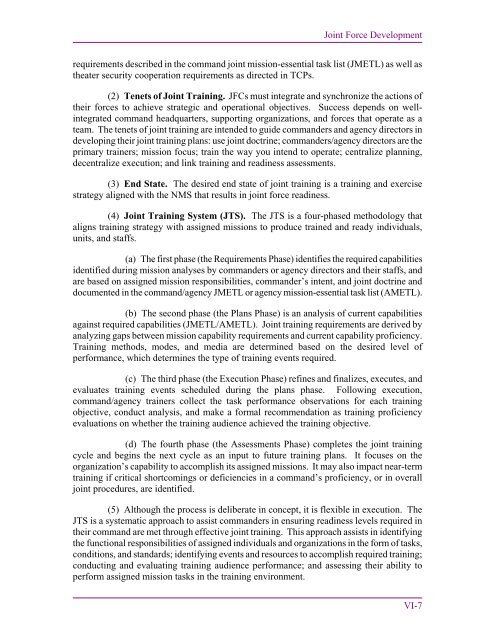JP 1, Doctrine for the Armed Forces of the United States - Defense ...
JP 1, Doctrine for the Armed Forces of the United States - Defense ...
JP 1, Doctrine for the Armed Forces of the United States - Defense ...
You also want an ePaper? Increase the reach of your titles
YUMPU automatically turns print PDFs into web optimized ePapers that Google loves.
Joint Force Development<br />
requirements described in <strong>the</strong> command joint mission-essential task list (JMETL) as well as<br />
<strong>the</strong>ater security cooperation requirements as directed in TCPs.<br />
(2) Tenets <strong>of</strong> Joint Training. JFCs must integrate and synchronize <strong>the</strong> actions <strong>of</strong><br />
<strong>the</strong>ir <strong>for</strong>ces to achieve strategic and operational objectives. Success depends on wellintegrated<br />
command headquarters, supporting organizations, and <strong>for</strong>ces that operate as a<br />
team. The tenets <strong>of</strong> joint training are intended to guide commanders and agency directors in<br />
developing <strong>the</strong>ir joint training plans: use joint doctrine; commanders/agency directors are <strong>the</strong><br />
primary trainers; mission focus; train <strong>the</strong> way you intend to operate; centralize planning,<br />
decentralize execution; and link training and readiness assessments.<br />
(3) End State. The desired end state <strong>of</strong> joint training is a training and exercise<br />
strategy aligned with <strong>the</strong> NMS that results in joint <strong>for</strong>ce readiness.<br />
(4) Joint Training System (JTS). The JTS is a four-phased methodology that<br />
aligns training strategy with assigned missions to produce trained and ready individuals,<br />
units, and staffs.<br />
(a) The first phase (<strong>the</strong> Requirements Phase) identifies <strong>the</strong> required capabilities<br />
identified during mission analyses by commanders or agency directors and <strong>the</strong>ir staffs, and<br />
are based on assigned mission responsibilities, commander’s intent, and joint doctrine and<br />
documented in <strong>the</strong> command/agency JMETL or agency mission-essential task list (AMETL).<br />
(b) The second phase (<strong>the</strong> Plans Phase) is an analysis <strong>of</strong> current capabilities<br />
against required capabilities (JMETL/AMETL). Joint training requirements are derived by<br />
analyzing gaps between mission capability requirements and current capability pr<strong>of</strong>iciency.<br />
Training methods, modes, and media are determined based on <strong>the</strong> desired level <strong>of</strong><br />
per<strong>for</strong>mance, which determines <strong>the</strong> type <strong>of</strong> training events required.<br />
(c) The third phase (<strong>the</strong> Execution Phase) refines and finalizes, executes, and<br />
evaluates training events scheduled during <strong>the</strong> plans phase. Following execution,<br />
command/agency trainers collect <strong>the</strong> task per<strong>for</strong>mance observations <strong>for</strong> each training<br />
objective, conduct analysis, and make a <strong>for</strong>mal recommendation as training pr<strong>of</strong>iciency<br />
evaluations on whe<strong>the</strong>r <strong>the</strong> training audience achieved <strong>the</strong> training objective.<br />
(d) The fourth phase (<strong>the</strong> Assessments Phase) completes <strong>the</strong> joint training<br />
cycle and begins <strong>the</strong> next cycle as an input to future training plans. It focuses on <strong>the</strong><br />
organization’s capability to accomplish its assigned missions. It may also impact near-term<br />
training if critical shortcomings or deficiencies in a command’s pr<strong>of</strong>iciency, or in overall<br />
joint procedures, are identified.<br />
(5) Although <strong>the</strong> process is deliberate in concept, it is flexible in execution. The<br />
JTS is a systematic approach to assist commanders in ensuring readiness levels required in<br />
<strong>the</strong>ir command are met through effective joint training. This approach assists in identifying<br />
<strong>the</strong> functional responsibilities <strong>of</strong> assigned individuals and organizations in <strong>the</strong> <strong>for</strong>m <strong>of</strong> tasks,<br />
conditions, and standards; identifying events and resources to accomplish required training;<br />
conducting and evaluating training audience per<strong>for</strong>mance; and assessing <strong>the</strong>ir ability to<br />
per<strong>for</strong>m assigned mission tasks in <strong>the</strong> training environment.<br />
VI-7

















